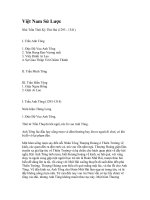Tài liệu Make Millions and Make Change 9 docx
Bạn đang xem bản rút gọn của tài liệu. Xem và tải ngay bản đầy đủ của tài liệu tại đây (45.98 KB, 10 trang )
Make Millions and Make Change!
80
Any information you want to disclose should be prepared in advance,
so you are not caught with your guard down. It is also a good idea to
know in advance what type of deal you might accept, if any.
If you do not want to sell your company for a fair market value, then
do not waste your time and money by working with people interested
in mergers and acquisitions. They will not pay more than what it is
worth, and you will not sell for less.
The most common, conservative model a buyer is likely to use to
estimate your target corporation’s current value is discounting your
estimated future cash flows back to what they would be worth today,
given their expected profit margins over time, taking in to account the
other opportunities for your assets and expected interest rates. That
will be used as a guidepost for their offer, which is likely to have many
interrelated parts, generally including some at risk components, like
stock options and “earn outs.”
There are many factors a buyer will consider to determine your
“estimated future cash flow,” which you must also consider for your
business “narrative” to the buyer to create the intended perception.
They will be interested in your longevity, intellectual property,
resumes and bios, customer lists and contracts, debts, service liabilities
and opportunities, leases, hard assets, non-competed and proprietary
invention agreements for staff, the sanctity of your “books,” and a
variety of other objective and subjective measurements in their “due
diligence” process.
Best Practices as Weapons
81
Ideally, if you personally like someone, which would be considered
the “social” aspect of a deal, and you believe that they represent the
best potential buyer of your company, then you might give their offer
extra consideration beyond its price.
However, keep in mind that the attitudes the buyers present might not
be genuine, and the people with the most money can afford to put on
the nicest presentations, often without being questioned by seemingly
lower level businesspersons.
If your own job is going to survive past a buyout or merger, you will
definitely want to make sure that you are working with the right
people. With that in mind, spend a good amount of time with the
prospective buyers to see if your social values and communications
mannerisms are compatible.
Your evaluation of the buyers should take into account intangibles like
courtesy and stress level during negotiations and beyond. But do not
let their visits become intrusions and distract you from your daily
business processes, or your company could become worthless during
that period when you are trying to “flip it.”
A Letter of Intent (LOI) or term sheet, which proposes some of the
key deal terms in a professional manner, may not be “bankable” but
could be a good start to a longer term, more serious deal and
relationship. However, you ultimately need bona fide, fully executed,
binding contracts (Operating Agreements/Private Placement
Memoranda/Subscription Agreements), which has been blessed by
your legal counsel, before you should feel comfortable that your
merger and acquisition attempts were a success.
Make Millions and Make Change!
82
A common package of buyout terms may include any combination of
cash, stock and performance-based incentives, including “earn-outs,”
which are tied to future revenues, profits, or events, as opposed to just
stock price.
Overall, you want to understand the total value of the “package” you
are being offered from buyers—and do not believe it until you see it in
writing. Each piece of their offer should be balanced with the others
until you feel comfortable with your overall impression of what is
being offered.
If you get fewer shares of stock, you should get more cash or other
incentives. The overall package, including the aforementioned social
aspects of the deal, is what you need to weigh against any other
possible offers. If there are no other offers, you can keep growing the
company independently and try to sell it again later, or you can choose
to take the best of what you are presently being offered.
Most of the intrinsic value in companies is usually created in its
formative years. If you are productive in the early years of corporate
evolution and less productive or interested in more mature operations,
you could earn more money by starting and selling many different
early-stage companies. On the other hand, switching could have
consequences too: like paying extra taxes, possibly needing to learn a
new business, and definitely having to re-orientate yourself to new
players in new markets, i.e., lost leverage.
Best Practices as Weapons
83
Another potential problem is that you could have a non-compete
agreement, which would prevent you from competing with your
former employer, the company to whom you sold out, and thus require
you to start in a completely new industry or territory.
Should you employ this early-stage sell strategy, the best bet to
employ would be to focus on emerging industries, even though they
are the most risky. By definition, emerging business niches do not
have entrenched players. Generally, you can compete head-to-head
with any industry entrant at your level of sophistication and wealth in
emerging markets.
If the game is decided by heavy up-front capital expenditures, then the
person or company with the most cash will likely win. However, small
emerging industries, which are not terribly capital-intensive, are open
to everyone.
When you choose to sell your company, you will need to decide if
your company is big enough to require an outside business broker to
create merger and acquisition opportunities or if a great lawyer and
accountant will suffice, with your own leadership. Are people already
making fair, unsolicited offers, or is it going to be a much more
difficult process requiring more calendar or clock time and some
professional help?
Make Millions and Make Change!
84
There is a common method used in mergers and acquisitions that can
help determine the fair market value of your company. FMV is the
only price for which you can sell out; nobody wants to be in on a deal
where fairness is not taken into account.
The idea is to create an equation where you can plug in your
company’s “numbers” to arrive at FMV. Generally, a buyer who wants
to disclose his valuation methods refers to a multiple of revenues or
profits. This should equate to what they claim to be the FMV of your
company.
Often, industry players create commonly known multiples for
companies who have similar histories, financial results, and corporate
structures. Irrespective of market makers’ attempts to homogenize
companies, once you review any of them in detail you’ll find that all
companies and deals are truly unique and therefore require dynamic
human and industry research, abstract insight, and a diligent work
effort to discern the information you will need to make or receive a
merger offer. For a small Internet company, a popular multiple is eight
years of the company’s profits (an 8X multiple). If you succeed in
selling your company for a multiple of eight times your annual profits,
you get the earnings of eight years hard labor (assuming no growth) in
one payment (or however many payments you agree to). In addition,
you can compound all that money for the eight years you would have
otherwise been working, while saving all the opportunity cost and time
to perform another mission of equal or greater importance or
profitability.
This same company may have a 25% profit margin; therefore, their
revenue would be four times as high, making their “multiple to
revenues” equal 2x to go with the 8x “multiple to profits.”
Best Practices as Weapons
85
Selling your company may save you years of work if the buyer
delivers you those same years of expected profits from your
operations, but years in advance. On the other hand, if you do not
successfully make your transaction you could end up investing a lot of
time and money in the sale-making process for negative returns.
Whatever your goals, you should run business “as usual” during any
sales process. It is vital to build long-term value in your company,
whether you choose to sell eventually or not. Buyers only want to buy
assertive companies with bright prospects and current growth, not
short-term schemes.
Kaizen: A Japanese Way to Approach Best Practices
“Kaizen” is a Japanese approach to the workplace that has proven to
be a famously effective Best Practices strategy with companies like
Toyota and Sony, among others. “Kai” is defined as continuous
improvement while “Zen,” a more familiar term, is loosely translated
as for the better or “good.” Therefore, kaizen is to make “continuous
improvements for the good.”
Kaizen follows three principles: 1) process and results 2) systemic
thinking (the big picture), and 3) non-blaming, because to blame is
counter-productive and wasteful in practice.
When kaizen is applied as a daily process, everyone in the company is
involved, from the CEO and management team to your employees.
The purpose of kaizen in the workplace is to eliminate the waste (or
“muda” in Japanese) that is produced by your company, like waste in
poor time management, inner office clutter, and other inefficient
Make Millions and Make Change!
86
methods, while freeing opportunities. Some companies hold a “Kaizen
Event” where managers and employees work together to fine-tune and
revise the current standards. Once a more efficient and superior system
is achieved, it is then standardized and integrated into current policies,
rules, and Standard Operating Procedures (SOPs).
When you implement kaizen into the workplace, you should aspire to
make changes to your current operating standards by breaking down
the processes in detail, monitoring the results, and then making
adjustments accordingly (“If it ain’t broke, do fix it”).
Your management team should ensure that the current SOPs are being
followed and achieved while human resources look after the follow-
ups. Management must “go and see” operations, MBWO (management
by walking around) in order to achieve efficient operations and take
corrective actions when required. That is the only way they can fully
understand their current business climate and make educated
adjustments.
The Toyota Corporation is renowned for its production system, The
Toyota Production System, and its principles, The 14 Principles of the
Toyota Way. Kaizen is the leading philosophy behind their efficient
and productive systems and methods. Jeffrey Liker is the author of The
Toyota Way: 14 Management Principles from the World’s Greatest
Manufacturer. He writes, “The main ideas are to base management
decisions on a philosophical sense of purpose and think long-term, to
have a process for solving problems, to add value to the organization
by developing its people, and to recognize that continuously solving
root problems drives organizational learning.”
Best Practices as Weapons
87
The Toyota Way has been called “a system designed to provide the
tools for people to continually improve their work.” If you are not
striving for constant improvements within your company, your
business is not evolving, and neither are your employees.
Since everyone on your team should be included in creating and
attaining a well-organized, competent and economical system, the
benefits of empowering your employees creates yet another virtuous
cycle. It enriches the workplace and the work experience by allowing
members of your company to excel and “bring out their best.”
After you and your team have created more efficient processes, you
will gain faster lead times as well as keep wages down, all of which
will help keep you ahead of your competition. You can then add those
new moneymaking activities to your Best Practices and SOP arsenals
for redistribution and reinforcement.
The methods that can help you successfully manage and organize the
workplace in kaizen are called the 5S’s, or “good housekeeping,” as
referred to by others. They are set in place with the intention to
simplify the work environment.
The 5S’s are loosely translated as:
Seiri (Tidiness): Unused and unneeded items are cleared out (this
applies to your contact management system too). Keeping your data
organized, refreshed, properly labeled and backed up are efficient
ways for you and your staff to locate data as needed. The benefits of
applying Seiri are a safer and tidier environment, less time wasted
when searching for items, fewer hazards, less clutter to interfere with
productive work space, and additional space from cleared out items.
Make Millions and Make Change!
88
Seiton (Orderliness): “A place for everything, and everything in its
place.” Seiton focuses on the need for an orderly workplace to promote
workflow.
Seiso (Cleanliness): Indicates the need to keep the workplace clean
daily, as well as neat. The key point is that maintaining cleanliness
should be part of the daily work—not an occasional activity initiated
when things get too messy.
Seiketsu (Standardization): When the first three are set in place, they
are then standardized. Create the rules, and then regulate them. Since it
is easy to fall into old habits, this sets easy-to-follow standards and
develops structure and conformity.
Shitsuke (Sustenance): This refers to educating and maintaining
standards. Once the previous 4S’s have been established, they become
the new way to operate. Maintain the system and continue to improve
it.
Best Practices for Your Team
The following list of Best Practices is a guideline to get your
employees organized and in the right direction. We invite you to use
these ideas with your staff, elaborate on them, and expand them as
needed.
1. Pay attention to details. Always return phone calls, spell
properly in client communications, pass on messages, clear all
problems to the client’s satisfaction, keep your paperwork and
computer files orderly, discuss timely opportunities/concerns
Best Practices as Weapons
89
with others, keep updated to-do lists and manage specified
responsibilities. If a client or prospect requires information
then make sure the fax or email that you sent to them has a
clean, professional cover letter on it. Ensure the cover letter has
the correct spelling of the client’s name and his regular phone
number, so you can follow up on his needs and verify the
successful receipt of the communication.
2. Offices should be clean and orderly, and you should encourage
random and scheduled client visits. Everything should have a
prescribed home: paperwork, disks, cables, shared hard drive
files. Every teammate requires easy access to whatever
resources they need.
3. Be patient and polite to all clients and prospects but move to
quality conclusions quickly. Ideas must become realities
quickly. No entrenched ideas or positions should hold you
back—be open to new and better ways of operating.
4. Be entirely customer-focused; be committed to providing the
best solutions for your clients’ needs without sacrificing the
bottom line. Constantly communicate with existing and
prospective clients regarding many services and issues. Staff
from multiple departments should make calls to clients to
“check-in” on their satisfaction and offer additional service.
Talk and meet with clients more often and study their needs.









